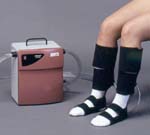

 |  |
TREATING INOPERABLE CIRCULATION DISORDERS

![]() In November 2001, Paul S. van Bemmelen, MD, PhD,
clinical assistant professor of surgery, and fellow members of
our vascular surgery division published an article in the
Archives of Surgery describing the clinical study of a
nonsurgical treatment of inoperable circulation disorders. This novel treatment is good news for patients with poor
circulation who are not good surgical candidates.
In November 2001, Paul S. van Bemmelen, MD, PhD,
clinical assistant professor of surgery, and fellow members of
our vascular surgery division published an article in the
Archives of Surgery describing the clinical study of a
nonsurgical treatment of inoperable circulation disorders. This novel treatment is good news for patients with poor
circulation who are not good surgical candidates.
The first author of the report, Dr. van Bemmelen is a pioneer in the use of external intermittent compression devices for treating circulation disorders in patients for whom surgery is not possible.
Dr. van Bemmelen is the inventor of the patented arterial assist device called ArtAssist, which is currently used throughout the world. He has the longest clinical experience with the use of this device for the treatment of rest-pain, necrosis (black discoloration) of parts of the foot, and intermittent claudication (walking difficulty).
Typical reasons to use this type of treatment are: advanced age and poor medical condition, multiple previous bypass attempts, lack of veins that could be used to make a new bypass, and lack of distal outflow arteries in the foot to which to connect a bypass.
ARTERIAL ASSIST
Dr. van Bemmelen's arterial assist device applies a unique form of pneumatic compression to the foot, ankle, and calf to increase arterial blood flow to the lower limbs. The device triples blood flow at the tissue level. It provides a compression regimen that effectively simulates the beneficial effects of brisk walking, without pain or tissue trauma.

![]() First, using wrapped cuffs, the device compresses the foot and
ankle. A second later the calf is compressed, and the foot,
ankle, and calf veins are almost completely emptied. In return,
the arterial blood is more easily pushed down to the toes and
blood-deprived tissues.
First, using wrapped cuffs, the device compresses the foot and
ankle. A second later the calf is compressed, and the foot,
ankle, and calf veins are almost completely emptied. In return,
the arterial blood is more easily pushed down to the toes and
blood-deprived tissues.
A second mechanism of action accounting for the large blood-flow increase involves the endotheliumócells that form the lining of all blood vessels. The endothelial cells release important biochemical factors, such as nitric oxide that helps circulate the blood. This substance is released in amounts corresponding to the rate of blood flow moving along the cells that line the vessels.
Patients with poor circulation (peripheral arterial occlusive disease) have lost pulsatile blood flow, and their blood circulates in a sluggish manner. This inhibited movement causes a loss of those important biochemical factors needed to maintain proper circulation.
When the arterial assist device is used, pulsatility is returned to a limb by rapid compression. This creates high flow rates intended to stimulate release of these important biochemical factors and likely stimulates the formation of collateral vessels.
BIO-NOTE
Dr. van Bemmelen, who joined the Department in 1998, is currently co-director of University Hospital's Leg and Foot Ulcer Treatment Group, medical director of the Non-Invasive Vascular Laboratory, and chief of vascular surgery at the Northport Veterans Affairs Medical Center.
Dr. van Bemmelen received his MD from the University of Leiden (Netherlands) in 1978, and his PhD from the University of Amsterdam in 1985, for which he developed an experimental model of venous hypertension to study damage to vein valves.
After completing his general surgery residency in Rotterdam in 1988, Dr. van Bemmelen went to the University of Washington in Seattle for a one-year research fellowship in vascular surgery. He then returned to the Netherlands for a two-year clinical fellowship in general vascular surgery.
In 1991, Dr. van Bemmelen returned to the United States, going to Southern Illinois University, where he completed his residency training in general vascular surgery. From there he relocated to Long Island, establishing a private practice in Port Jefferson, NY, and subsequently joining our vascular surgery team.
Dr. van Bemmelen's clinical practice encompasses all aspects of general vascular surgery. Areas of particular interest include wound care management; noninvasive vascular diagnosis with color-duplex in arterial and venous disease; nonsurgical treatments for vascular disorders; use of laser-Doppler techniques to study changes in the circulation of the skin in pathological states (e.g., diabetes, arterial disease, and venous insufficiency) and their relationship with ulceration of the toes, feet, ankle, and legs.
For consultations/appointments with Dr. van Bemmelen, please call 631-444-4545. Patients who already have undergone arteriography/angiography should bring the x-ray films with them at the time of their initial consultation.
|
FROM THE MEDICAL LITERATURE . . . Limb Salvage Using High-Pressure Intermittent Compression Arterial Assist Device in Cases Unsuitable for Surgical Revascularization
Hypothesis: Intermittent compression therapy for
patients with inoperable chronic critical ischemia with rest pain
or tissue loss may have beneficial clinical and hemodynamic
effects. van Bemmelen PS, Gitlitz DB, Faruqi RM, Weiss-Olmanni J, Brunetti VA, Ricotta JJ. Limb salvage using high-pressure intermittent compression arterial assist device in cases unsuitable for surgical revascularization. Archives of Surgery 2001;136:1280-6. |
| Back to Departmental News | Return to Home Page |